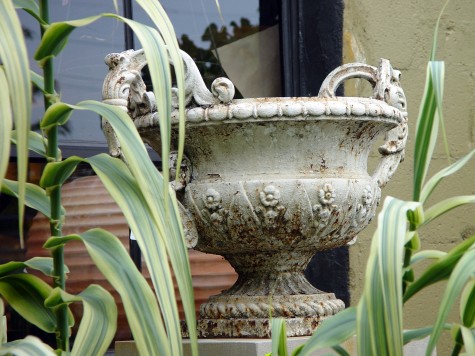 Gardeners make choices based on lots of issues, but most can figure out what appeals to them straight off. Some love old crusty, rusty and well worn antiques; others find that state of gentle disrepair lacks visual punch. Many antique urns have been painted at one time or another; white having been a very popular color. Worn white will either be just the thing, or seem jarring. For others, the prospect of a classical urn leaves them cold-old or new. But if the idea of an urn resonates with you, which you will choose depends on several things.
Gardeners make choices based on lots of issues, but most can figure out what appeals to them straight off. Some love old crusty, rusty and well worn antiques; others find that state of gentle disrepair lacks visual punch. Many antique urns have been painted at one time or another; white having been a very popular color. Worn white will either be just the thing, or seem jarring. For others, the prospect of a classical urn leaves them cold-old or new. But if the idea of an urn resonates with you, which you will choose depends on several things.
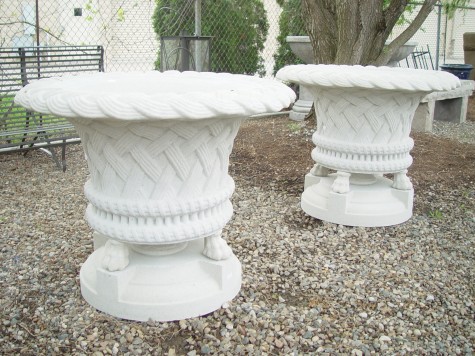 Dry cast limestone urns are usually based on classical handcarved limestone designs dating back hundreds of years. Many of those designs are European in origin. Dry cast limestone is a process by which limestone dust is mixed with a binder, and poured into molds. These reproductions are much more affordable than their antique counterparts. Some old designs would not be available at all, but for a reproduction. On occasion I find a piece I feel I must have, with no placement in mind. But a classical European urn may be very much out of place in front of a Cape Cod home. Now would these elaborately footed urns ring right against the backdrop of my own arts and crafts style home. However, they might be elegant and unexpectedly beautiful in a contemporary setting. The location you have in mind should influence your decision.
Dry cast limestone urns are usually based on classical handcarved limestone designs dating back hundreds of years. Many of those designs are European in origin. Dry cast limestone is a process by which limestone dust is mixed with a binder, and poured into molds. These reproductions are much more affordable than their antique counterparts. Some old designs would not be available at all, but for a reproduction. On occasion I find a piece I feel I must have, with no placement in mind. But a classical European urn may be very much out of place in front of a Cape Cod home. Now would these elaborately footed urns ring right against the backdrop of my own arts and crafts style home. However, they might be elegant and unexpectedly beautiful in a contemporary setting. The location you have in mind should influence your decision.
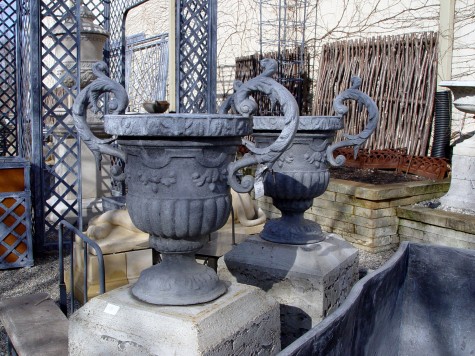 The scale of an urn is an important consideration. Very small urns may need pedestals to set them off properly. If the shape and decoration of an urn is a good bit of what you find appealing, then they need be placed where those things can be easily seen. Small urns have another significant disadvantage. From a small size follows a small planting area; you will need to edit your plant choices. Perhaps of more importance-how easily will you be able to water, and water again, when the weather gets hot? Small pots dry out faster than is easy to keep up with.
The scale of an urn is an important consideration. Very small urns may need pedestals to set them off properly. If the shape and decoration of an urn is a good bit of what you find appealing, then they need be placed where those things can be easily seen. Small urns have another significant disadvantage. From a small size follows a small planting area; you will need to edit your plant choices. Perhaps of more importance-how easily will you be able to water, and water again, when the weather gets hot? Small pots dry out faster than is easy to keep up with.
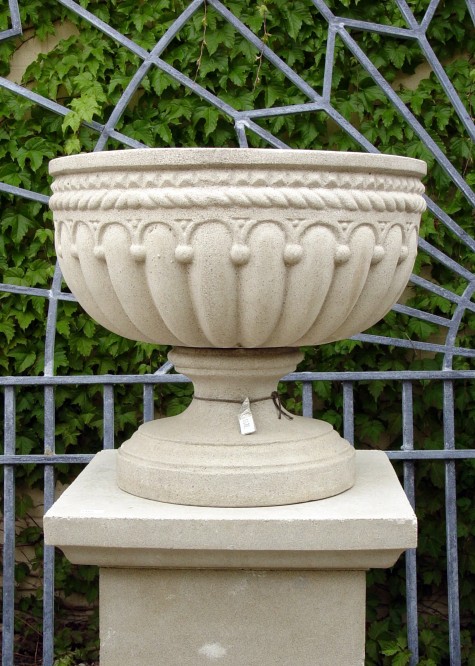 I like urns of a generous size. I have plenty of room to plant-either lots of one thing, or a collection. An urn planted such that in late summer it is a garden bouquet of good size is a pleasure. Watered properly, they retain moisture evenly, over a longer period of time. A container that can wait for me to get there with the hose- this I appreciate. Any urn I plant becomes part of the working garden. A gorgeous urn with a poor planting is a frustration no gardener needs.
I like urns of a generous size. I have plenty of room to plant-either lots of one thing, or a collection. An urn planted such that in late summer it is a garden bouquet of good size is a pleasure. Watered properly, they retain moisture evenly, over a longer period of time. A container that can wait for me to get there with the hose- this I appreciate. Any urn I plant becomes part of the working garden. A gorgeous urn with a poor planting is a frustration no gardener needs.
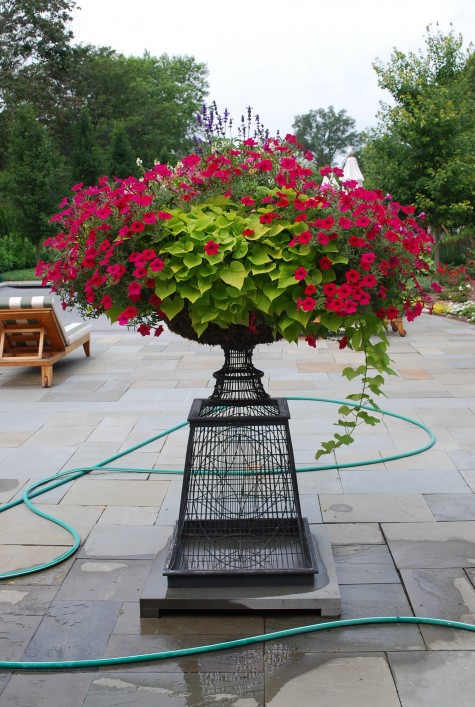
This English wirework urn is of English manufacture. It has a matching pedestal, which provides plenty of height for a good show of trailing plants off the rim. The bowl of the urn has all but disappeared by late summer. In this case, the lush planting is of more important visual importance than the urn itself. The plainest most homely galvanized bucket can be glorious- given an inspired planting. The only advantage of a decorative urn is a beautiful appearance during those times when they are not planted. In some situations, a container which is also a sculpture is a good idea.
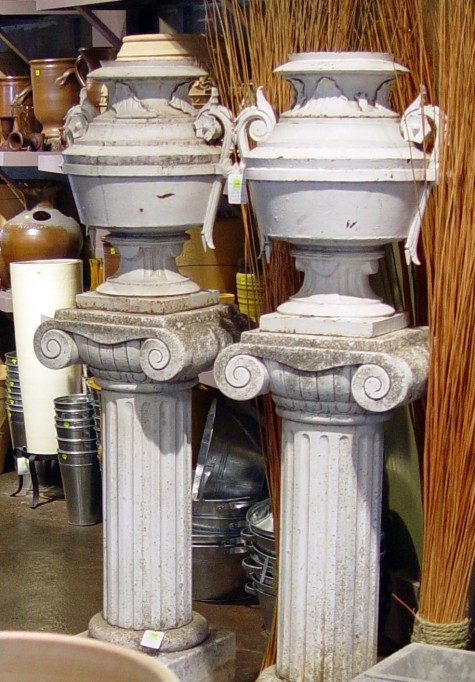 These French art deco style urns have such style and presence one might be inclined not to plant them. The Waterloo Urn I discussed in yesterday’s post is placed out in the open landscape. Unplanted, it could be placed anywhere calling for a sculpture-no need to have water conveniently nearby.
These French art deco style urns have such style and presence one might be inclined not to plant them. The Waterloo Urn I discussed in yesterday’s post is placed out in the open landscape. Unplanted, it could be placed anywhere calling for a sculpture-no need to have water conveniently nearby.
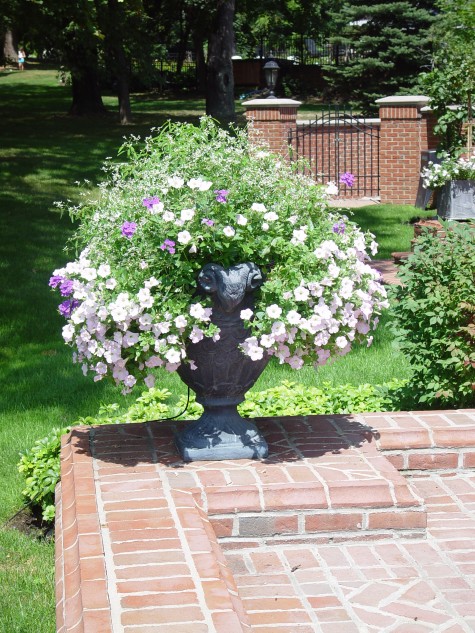 This lead urn is watered via a tube connected to the irrigation system in this yard. In much the same way as greenhouses tube their hanging baskets, or geraniums, these tubes buy a gardener a little time. They are not really a substitue for hand watering, as the coverage can be uneven, too long, or too short. If the tube runs on a nearby irrigation zone, that pot is at the water mercy of whatever else is being primarily watered. I am more than willing to look after my plantings; some automatic irrigation helps me to hedge this pledge. Those days that I come home really late will not need be a crisis. The level of your ability to maintain pot plantings is an important part of the selection process.
This lead urn is watered via a tube connected to the irrigation system in this yard. In much the same way as greenhouses tube their hanging baskets, or geraniums, these tubes buy a gardener a little time. They are not really a substitue for hand watering, as the coverage can be uneven, too long, or too short. If the tube runs on a nearby irrigation zone, that pot is at the water mercy of whatever else is being primarily watered. I am more than willing to look after my plantings; some automatic irrigation helps me to hedge this pledge. Those days that I come home really late will not need be a crisis. The level of your ability to maintain pot plantings is an important part of the selection process.
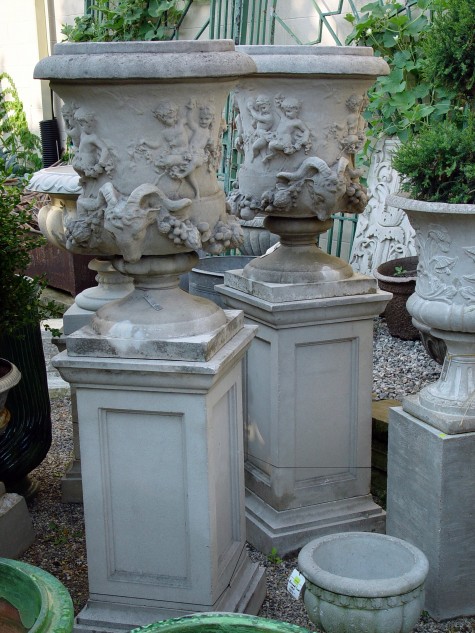 These concrete pots are English made reproductions, but they have that aged look. The surface is such that I would plant the tall, and vase shaped-nothing trailing. Ala some voluminously opulent Flemish flower painting. There is no choosing these pots if the decorative story being told does not greatly appeal-why cover up what so appealed to you in the first place? In this case, the urns and there plantings need to strike a balance, so they look great in relationship to one another.
These concrete pots are English made reproductions, but they have that aged look. The surface is such that I would plant the tall, and vase shaped-nothing trailing. Ala some voluminously opulent Flemish flower painting. There is no choosing these pots if the decorative story being told does not greatly appeal-why cover up what so appealed to you in the first place? In this case, the urns and there plantings need to strike a balance, so they look great in relationship to one another.
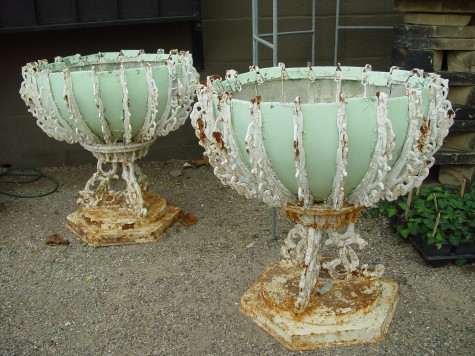
These cast iron urns with zinc liners are French from the Victorian period. That French green color is a dead giveaway. Their unusual and striking design would make them sensational in the right place. My year 1 choice would be to plant these with big blue agaves, and call it a day. After one season, something even more fabulous may come to mind. I will admit I did buy my house 15 years ago for the four urns outdoors that were original to the house-I had to have them.